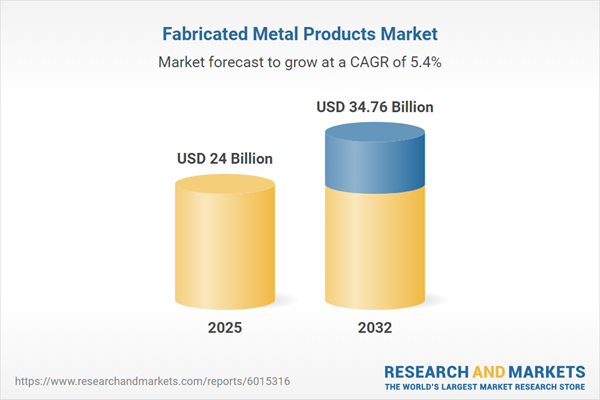Speak directly to the analyst to clarify any post sales queries you may have.
The fabricated metal products market is undergoing significant transformation as digitalization, regulatory requirements, and changing supply chain dynamics prompt senior decision-makers to reassess strategies for operational resilience and growth.
Market Snapshot: Fabricated Metal Products Market Outlook
The global fabricated metal products market, a backbone of the manufacturing sector, is projected to increase from USD 22.77 billion in 2024 to USD 24 billion in 2025. With a compound annual growth rate of 5.43%, the market is expected to reach USD 34.76 billion by 2032. This market underpins critical industries such as automotive, aerospace, construction, and machinery, all of which demand robust quality and reliability. Enhanced digital adoption helps manufacturers maintain competitiveness, achieve compliance, and address evolving quality standards. As Industry 4.0 accelerates, innovative fabricated metal products serve as core enablers for modernizing production systems and reinforcing supply chains.
Scope & Segmentation of the Fabricated Metal Products Market
- Product Types: Covers castings, fabricated assemblies, forgings, stampings, and welded products designed to meet diverse requirements ranging from infrastructure and industrial projects to specialized energy solutions.
- Raw Materials: Includes aluminum, copper, stainless steel, steel, and titanium, each selected to ensure durability, improve sustainability profiles, and align with evolving environmental regulations.
- Manufacturing Processes: Involves cutting, forming, joining, and finishing supported by advanced methods such as laser, plasma, and waterjet processing, which deliver both precision and scalability for varied industrial volumes.
- End-User Industries: Encompasses aerospace, automotive, construction, electrical, and general machinery sectors, all leveraging metal fabrication for increased productivity, enhanced sustainability, and improved performance characteristics.
- Sales Channels: Incorporates direct sales, channel distributors, partnerships with original equipment manufacturers (OEMs), and digital platforms, improving access, procurement agility, and responsiveness for tailored and urgent requirements.
- Geographies: Spans the Americas, Europe, Middle East & Africa, and Asia-Pacific, with each region adapting to unique regulatory frameworks, compliance priorities, and distinct market drivers that inform tailored growth strategies.
- Key Companies Covered: Highlights leaders including Reliance Steel & Aluminum Co., Steel Dynamics, Nucor Corporation, Alcoa Corporation, Arconic Corporation, Worthington Industries, TimkenSteel Corporation, Mueller Industries, American Axle & Manufacturing Holdings, and Crane Co. These companies set global benchmarks for innovation, operational excellence, and best practices.
Key Takeaways for Senior Decision-Makers
- Implementing Industry 4.0 and smart manufacturing initiatives enhances operational efficiency and supports faster alignment with regulatory and customer expectations.
- Reinforcing supply chain resilience through diverse sourcing and strong partner networks lowers risk and improves adaptability during regulatory and market shifts.
- Prioritizing environmental responsibility and supply chain transparency supports sustainability objectives and strengthens organizational reputation among stakeholders.
- Leveraging digital sales channels ensures quicker responsiveness, particularly in markets requiring custom or time-sensitive metal fabrication solutions.
- Developing lightweight and high-strength designs helps address new market demands related to electrification, decarbonization trends, and infrastructure investment.
- Regional priorities vary: infrastructure investment shapes the market in the Americas, automation leads growth in Asia-Pacific, and regulatory adaptation is a focus in EMEA.
Tariff Impact: Navigating United States Tariff Changes in 2025
Anticipated tariff changes in the United States are altering procurement decisions and price management strategies within the fabricated metal products market. More organizations are adopting local sourcing approaches and deepening collaboration with regional recycling partners to reduce the risks of supply disruption. Senior leaders are evolving hybrid supply chains and introducing proactive risk management strategies to support business continuity and meet advancing sustainability objectives amid ongoing regulatory shifts and uncertainty.
Research Methodology & Data Sources
This analysis draws from executive interviews, site visits, and comprehensive secondary data review. All findings are validated through triangulation and scenario-based assessments to deliver strategic relevance for senior leaders in the fabricated metal products market.
Why This Report Matters: Strategic Value for Decision Makers
- Enables leaders to align investment and operational strategies with current trends in digital transformation, ensuring long-term business relevance.
- Provides actionable frameworks to navigate compliance and supply chain complexities, helping organizations recognize risks and opportunities in an evolving landscape.
- Supports continuous evaluation of resource, technology, and sourcing decisions to sustain competitive advantage and foster organizational growth.
Conclusion
Organizations advancing digital integration, supply chain strength, and compliance adaptability can realize sustained growth in the fabricated metal products market. Ongoing strategic flexibility will be vital to addressing sector challenges and capitalizing on evolving industry opportunities.
Additional Product Information:
- Purchase of this report includes 1 year online access with quarterly updates.
- This report can be updated on request. Please contact our Customer Experience team using the Ask a Question widget on our website.
Table of Contents
3. Executive Summary
4. Market Overview
7. Cumulative Impact of Artificial Intelligence 2025
Companies Mentioned
The companies profiled in this Fabricated Metal Products market report include:- Reliance Steel & Aluminum Co.
- Steel Dynamics, Inc.
- Nucor Corporation
- Alcoa Corporation
- Arconic Corporation
- Worthington Industries, Inc.
- TimkenSteel Corporation
- Mueller Industries, Inc.
- American Axle & Manufacturing Holdings, Inc.
- Crane Co.
Table Information
| Report Attribute | Details |
|---|---|
| No. of Pages | 197 |
| Published | October 2025 |
| Forecast Period | 2025 - 2032 |
| Estimated Market Value ( USD | $ 24 Billion |
| Forecasted Market Value ( USD | $ 34.76 Billion |
| Compound Annual Growth Rate | 5.4% |
| Regions Covered | Global |
| No. of Companies Mentioned | 11 |









